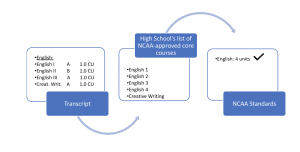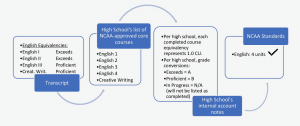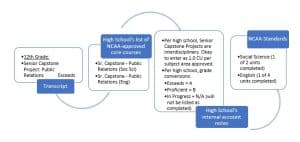NCAA Initial Eligibility and Student-Centered Learning
CompetencyWorks Blog
The NCAA initial eligibility process is a regulated and standardized process, while student-centered learning is anything but one-size-fits-all. A common concern in student-centered schools is that competency-based transcripts could hinder NCAA eligibility. This blog post explores what to expect throughout the NCAA school and course review process if you have a student-centered, competency-based model and reporting system.
The Basics of the NCAA
The National Collegiate Athletic Association (NCAA) is a membership organization with three divisions. Each division determines the rules under which its members will participate. The rules address recruiting, compliance, academic eligibility, championships, and more. The NCAA governance structure also includes various committees that develop policies and guidelines for enforcing the divisional rules. The member-driven rules, policies, and procedures are subsequently implemented and enforced by NCAA national office staff.
The NCAA’s mission-critical priorities are academics, fairness, and well-being. The pillar of academics includes both initial eligibility standards to ensure readiness for college coursework and continuing eligibility standards to reflect commitment to academics and progress toward a degree. NCAA Divisions I and II each have initial-eligibility requirements for core courses, credits, and grade point average (GPA) in addition to the unique acceptance criteria of each school, while Division III schools require students to meet the same overall standards as all students enrolling.
The High School Review Committee establishes policies and procedures related to the NCAA national office staff’s review of high schools and courses to determine which may be used for a student’s initial eligibility. The High School Review Committee is a common committee for both Divisions I and II, and it can make relevant recommendations for consideration by the Division I Committee on Academics and/or the Division II Academic Requirements Committee.

Standardized Requirements and Non-Standardized Learning
The NCAA initial-eligibility standards set by Division I and Division II members are based on NCAA-approved core courses, grades, and credits. These standards have been reviewed and adjusted over the years with support from the NCAA research staff to continue the aim of college readiness for student-athletes. Division I requires completion of 16 credits in NCAA-approved core courses across a certain subject-area distribution, 10 of which must be completed by the start of the 7th semester of high school, and a GPA of at least 2.3 in those core courses. Division II requires completion of 16 credits in NCAA-approved core courses across a certain subject-area distribution, and a GPA of at least 2.2 in those core courses.
On the surface, these course-, grade-, and credit-based standards (and the Division I, time-based requirement as well) don’t appear to meld with personalized and student-centered learning, particularly models that include interdisciplinary courses, project-based learning, or systems that are based on mastery of competencies and skills rather than completion of courses, proficiency levels, narrative grading, etc. However, in practice, this is an opportunity ripe for crosswalks between differentiated learning models and a standardized regulatory framework.

The Eligibility Center’s high school review staff works with high schools to understand their unique instructional model, curriculum, and assessments. This is an inherent part of the account and program review process if the high school is going through a first-time review with the Eligibility Center. Schools can also update their existing accounts with new information, such as when shifting to a new learning model. If the school’s transcript doesn’t present standard course titles, grades, or credits, the high school review team will ask the school to assist with conversions to note in their Eligibility Center account which serve as a “translation” between NCAA requirements and the school’s model and transcript.
Let’s back up and start with a simple example: The Eligibility Center receives a transcript uploaded from a high school for prospective student-athletes’ NCAA initial-eligibility certification. The transcript acts as a key for the processing staff to connect the high school’s list of NCAA-approved courses to the initial-eligibility requirements. If the transcript has familiar, subject-area-related course titles, grades, and credits, linking the transcript to the NCAA standards is straightforward. Core course titles from the transcript are matched with approved titles from the school’s Eligibility Center account, and the grades and credits on the transcript for those core courses count toward the required 16 credits and minimum GPA.

If any of those elements are presented differently on the transcript, it doesn’t necessarily mean it’s unusable, just that it needs a translation. For example, say the high school’s practice is to present sets of mastered competencies on the transcript as a list of completed courses that incorporate those competencies, but without credit values or traditional grades – as in the Courses Completed section of the Mastery Transcript, for example. The processing staff needs to know whether each course title represents a half credit, a full credit, a third credit, etc. to determine whether the student has completed the equivalent of 16 total credits across the required subject areas. Additionally, they need to know what level of proficiency each completed course title indicates to determine whether the student has demonstrated proficiency at an “A” level (4.0), “B” level (3.0), etc. in each course and whether they meet the minimum GPA threshold overall. Once this information is captured in the school’s Eligibility Center account as in the examples below, it will be referenced when reviewing future student-athletes’ transcripts, reducing the need for additional clarification.


Connecting with NCAA Staff
So how do these crosswalks come to be? For schools that have never completed an Eligibility Center review (you can check any school’s status and list of courses here), the first step is contacting the customer service dedicated high school line (877-622-2321) to begin the process if there is a possibility any current or future students will be interested in competing at an NCAA school. The review process will include questions and opportunities to share information about your curriculum, instruction, and assessment. For schools that already have active accounts but are shifting to a new model and new transcript format, the same dedicated high school line is a great way to notify the Eligibility Center about updated information. The high school review staff will then work with school contacts to develop crosswalks and account notes as needed, aiming to make the process as smooth and straightforward as possible.
The high school review team is also available to help brainstorm solutions or learn about research and policy shifts that may assist NCAA committees and member schools in rules modernization. This type of outreach from and with schools, districts, state departments of education, and research organizations has led to new or clearer policies for reviews such as “bridge” math courses and business courses and their use in initial eligibility. It has also been a critical part of the recommendations to adjust requirements for non-traditional coursework in initial eligibility. These recommendations would acknowledge changes in online and blended learning since the existing requirements became effective in 2010 and streamline the review process regardless of curriculum delivery model. Reach out with your questions and ideas – as educators are well aware, connection is at the heart of learning, growth, and improvement.
Learn More
- NCAA High School Initial-Eligibility Policy Updates: Expanding Opportunity for Student-Centered Learning Webinar
- Separating the Facts from the Myths in the Competency-Based High School Transcript
- The Evolution of NCAA Nontraditional High School Program Reviews
 Sarah Overpeck serves as director of high school review at the NCAA Eligibility Center, as well as primary liaison to the NCAA High School Review Committee. She holds a bachelor’s degree in mathematics and a minor in Spanish from Indiana University Bloomington, and she is a current MBA candidate at the Indiana University Kelley School of Business. Sarah has been part of the NCAA Eligibility Center for over 14 years across various roles in academic certification, high school review, and business process management. Prior to joining the NCAA, she was a high school mathematics teacher and track coach. Sarah is an avid runner and enjoys exploring the outdoors with her husband and dog.
Sarah Overpeck serves as director of high school review at the NCAA Eligibility Center, as well as primary liaison to the NCAA High School Review Committee. She holds a bachelor’s degree in mathematics and a minor in Spanish from Indiana University Bloomington, and she is a current MBA candidate at the Indiana University Kelley School of Business. Sarah has been part of the NCAA Eligibility Center for over 14 years across various roles in academic certification, high school review, and business process management. Prior to joining the NCAA, she was a high school mathematics teacher and track coach. Sarah is an avid runner and enjoys exploring the outdoors with her husband and dog.